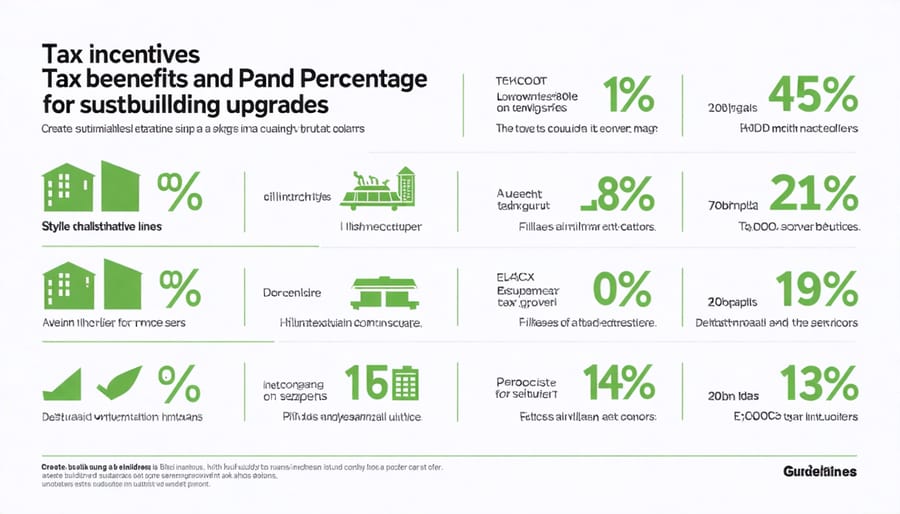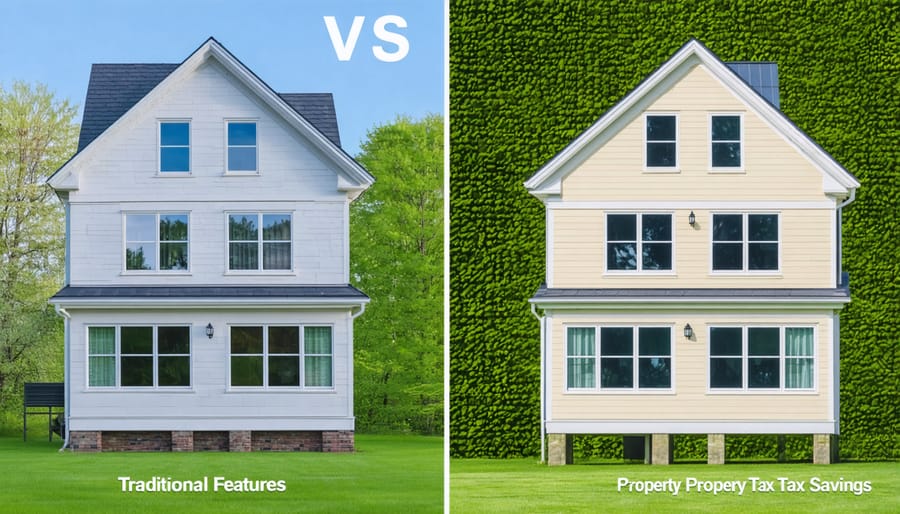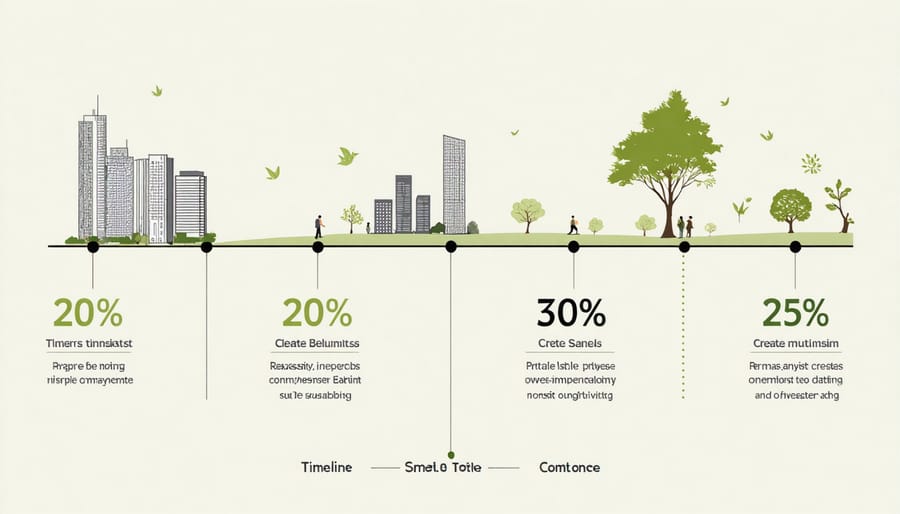Transform your investment portfolio while driving positive environmental change through sustainable investing – a strategy that’s revolutionizing wealth creation in today’s market. Recent data shows sustainable investments outperforming traditional portfolios by an average of 6.3% annually, making this approach both profitable and purposeful for property investors and fund managers alike.
Sustainable investing extends beyond simple environmental considerations, encompassing a powerful trilogy of returns: financial growth, tax advantages, and lasting social impact. Property investors who incorporate green building standards and energy-efficient upgrades not only benefit from reduced operating costs but also qualify for substantial tax incentives and increased property valuations. With the sustainable real estate market projected to reach $527.5 billion by 2027, early adopters are positioning themselves at the forefront of a transformative investment movement.
This practical guide explores how property owners can leverage sustainable investing strategies to maximize returns while contributing to environmental preservation. From energy-efficient retrofits to green building certifications, discover how aligning your investment strategy with sustainability principles can create lasting value for your portfolio and our planet.
Federal Tax Incentives for Sustainable Property Upgrades

Energy-Efficient Commercial Building Deductions
The Energy-Efficient Commercial Building Deduction, also known as Section 179D, offers significant tax benefits for property owners who implement sustainable building improvements. This federal tax incentive allows building owners to claim up to $1.88 per square foot for qualifying energy-efficient improvements installed in their commercial properties.
To qualify, buildings must demonstrate a reduction in total annual energy and power costs by at least 50% compared to a reference building that meets minimum requirements under ASHRAE Standard 90.1. The deduction covers three main building systems: interior lighting, HVAC and hot water systems, and the building envelope.
Property owners can claim partial deductions of $0.63 per square foot for each system that meets the energy reduction requirements independently. The certification process requires detailed energy modeling and verification by a qualified third-party professional to ensure compliance with IRS requirements.
Recent updates to Section 179D have made these deductions more accessible and valuable. Building owners can now claim the deduction multiple times for subsequent improvements, and public building owners can allocate the deduction to the designers responsible for the energy-efficient improvements.
For maximum benefit, property owners should maintain detailed documentation of improvements, energy savings calculations, and certification reports. Consider consulting with a tax professional familiar with sustainable building incentives to ensure proper qualification and maximum deduction potential.
Residential Energy Credits
Homeowners looking to embrace sustainable living can significantly benefit from various energy property tax credits offered at federal and state levels. These incentives make eco-friendly home improvements more financially attractive while reducing your carbon footprint.
The federal government currently offers up to 30% in tax credits for qualifying solar installations, including both photovoltaic systems and solar water heaters. Wind energy systems and geothermal heat pumps also qualify for similar credits. For those considering smaller upgrades, credits are available for energy-efficient windows, doors, insulation, and HVAC systems.
Many states provide additional incentives on top of federal credits. For example, some offer property tax exemptions for renewable energy installations, meaning your property taxes won’t increase despite the added home value. Others provide rebates or grants for specific energy-efficient improvements.
To maximize these benefits, homeowners should carefully document all improvements and retain receipts, manufacturer certifications, and energy performance ratings. It’s advisable to consult with a tax professional familiar with sustainable energy credits to ensure you’re claiming all eligible benefits. Remember that these credits can significantly reduce your initial investment costs while increasing your property’s long-term value and marketability.
State and Local Green Property Tax Incentives
Property Tax Exemptions
Property owners who invest in sustainable building features can benefit significantly from various home improvement tax credits and property tax exemptions. Many municipalities offer substantial reductions in property taxes for buildings that achieve recognized green certifications such as LEED, ENERGY STAR, or BREEAM.
These tax benefits typically range from 10% to 30% off annual property taxes, depending on the certification level and local jurisdiction. For example, properties achieving LEED Gold certification often qualify for a 20% reduction, while LEED Platinum buildings may receive up to 30% off their property tax assessments.
To qualify, buildings must typically meet specific sustainability criteria, including energy efficiency standards, water conservation measures, and sustainable material usage. The certification process requires thorough documentation and may involve initial investments, but the long-term tax savings often justify these upfront costs.
Commercial property owners should note that these exemptions can translate to significant annual savings, particularly for larger buildings. For a million-dollar commercial property, a 20% reduction could mean annual savings of several thousand dollars, creating substantial returns on sustainable investments over time.

Special Assessment Districts
Property Assessed Clean Energy (PACE) financing represents a game-changing approach to funding sustainable property improvements. This innovative financing mechanism allows property owners to fund energy efficiency upgrades, renewable energy installations, and water conservation projects through special tax assessments on their properties.
Under PACE programs, property owners can secure 100% upfront financing for sustainable improvements, which is then repaid through an assessment added to their property tax bill. This arrangement typically offers longer repayment terms (up to 20-30 years) and competitive interest rates compared to traditional financing options.
What makes PACE particularly attractive is that the assessment stays with the property rather than the owner. If you sell your property, the remaining assessment transfers to the new owner, who continues to benefit from the improvements and corresponding energy savings.
The tax benefits are substantial. Interest paid on PACE assessments may be tax-deductible, similar to property taxes. Additionally, the increased property value from sustainable improvements often qualifies for property tax incentives in many jurisdictions. Commercial property owners can potentially depreciate PACE-funded improvements, creating additional tax advantages.
Many municipalities across the country have embraced PACE programs, recognizing their potential to drive sustainable development while providing economic benefits to property owners.
ROI Analysis of Sustainable Property Investments

Short-term Tax Benefits
Sustainable property investments offer immediate tax benefits that can significantly boost your bottom line when structured correctly. Property owners who invest in eco-friendly improvements can maximize tax advantages through various federal and state incentives.
The most substantial short-term benefits come from energy-efficient improvement deductions, which can reach up to $1.80 per square foot for qualifying commercial properties. Residential property owners can claim up to 30% of the cost for solar installations, energy-efficient windows, and HVAC systems through federal tax credits.
Property tax assessments often provide additional relief, with many municipalities offering reduced rates for buildings meeting specific sustainability standards. These reductions can range from 5% to 20% of your annual property tax burden, depending on your location and the extent of green improvements.
For investors, accelerated depreciation schedules on sustainable equipment installations can provide immediate tax write-offs. This means you can deduct the full cost of qualifying improvements in the first year rather than spreading it over several years, significantly reducing your taxable income.
Remember to document all sustainable improvements and maintain proper certification records to ensure smooth tax filing and maximum benefit claims. Working with a qualified tax professional familiar with green building incentives can help you identify and capitalize on all available opportunities.
Long-term Value Appreciation
Sustainable property investments have consistently demonstrated their ability to appreciate in value over time, outperforming traditional properties in many markets. Properties with green certifications and energy-efficient features typically command premium prices, with studies showing a 7-10% higher resale value compared to conventional buildings.
This value appreciation stems from multiple factors. First, sustainable properties tend to have lower operating costs, making them more attractive to future buyers and tenants. Energy-efficient systems, water conservation features, and durable materials reduce monthly expenses while extending the property’s lifespan. Second, as environmental regulations become stricter, properties already meeting or exceeding sustainability standards become increasingly valuable assets.
The tax benefits associated with sustainable properties can be substantial and long-lasting. Property owners can take advantage of various incentives, including federal tax credits for solar installations, deductions for energy-efficient commercial buildings, and local property tax abatements. Many states offer additional tax breaks for green building certifications, creating multiple streams of tax savings that compound over time.
Furthermore, sustainable properties often qualify for preferential financing terms, including lower interest rates and extended loan terms through green mortgage programs. These financial advantages, combined with reduced insurance premiums for resilient building features, contribute to a stronger overall return on investment and enhanced long-term property value.
Implementation Strategies for Maximum Tax Benefits
Documentation Requirements
To claim tax benefits from sustainable investing, proper documentation is crucial. Keep detailed records of all green investments, including purchase receipts, certification documents, and energy performance assessments. For property-related sustainable investments, maintain copies of Energy Star certifications, LEED documentation, or other recognized green building certifications.
Essential paperwork includes itemized lists of energy-efficient improvements, manufacturer certifications for sustainable materials, and professional installation records. You’ll need Form 5695 for residential energy credits and Schedule A for relevant deductions on your tax return. Document energy savings through utility bills before and after improvements to demonstrate effectiveness.
For commercial properties, maintain Environmental Product Declarations (EPDs) and third-party verification reports. Keep records of renewable energy credits (RECs) and any local green building compliance certificates. Digital copies of all documentation should be stored securely, with backup physical copies maintained for at least seven years after claiming the benefits.
Consider working with a qualified tax professional who specializes in sustainable investments to ensure proper documentation and maximum benefit claims.
Timing Your Investments
Timing your sustainable property investments strategically can significantly enhance your tax advantages and overall returns. The optimal approach is to align your investments with the fiscal year and take advantage of seasonal incentive programs. For instance, many solar panel incentives and energy-efficient upgrade rebates are refreshed at the beginning of each calendar year, making January an ideal time to initiate these improvements.
Consider implementing sustainable upgrades during off-peak seasons when contractors typically offer more competitive rates. Fall and winter months often see reduced demand for installation services, potentially leading to better pricing and more flexible scheduling options. Additionally, many local and federal tax credits have specific deadlines or phase-out periods, making it crucial to time your investments accordingly.
For maximum tax benefits, consult with a tax professional before making major sustainable improvements. They can help you structure your investments to optimize deductions across multiple tax years and ensure compliance with current regulations. Remember that some sustainable improvements may qualify for immediate deductions, while others might need to be depreciated over time, affecting your investment timing strategy.
Professional Support
Navigating the complexities of sustainable investing becomes significantly easier with the right professional guidance. Working with experienced tax professionals who specialize in green investments can help you maximize available tax incentives and ensure compliance with evolving regulations. These experts can identify opportunities you might otherwise miss and help structure your investments for optimal tax efficiency.
Additionally, sustainability consultants bring valuable expertise in evaluating potential investments against environmental, social, and governance (ESG) criteria. They can assess property improvements for sustainability certification, recommend energy-efficient upgrades, and help you understand emerging green building standards. These professionals can also assist in developing a comprehensive sustainability strategy that aligns with both your investment goals and environmental values.
Consider creating a professional support team that includes both financial and sustainability experts. This collaborative approach ensures you’re making well-informed decisions that maximize both financial returns and environmental impact while staying compliant with relevant regulations and standards.
Sustainable property investment represents a powerful opportunity to align financial success with environmental responsibility. Throughout this exploration of sustainable investing benefits, we’ve seen how green properties can deliver superior returns while contributing to a more sustainable future. From substantial tax incentives and reduced operating costs to increased property values and enhanced tenant attraction, the advantages are clear and compelling.
The data consistently shows that sustainable properties outperform traditional investments, with lower vacancy rates, higher rental premiums, and reduced maintenance costs. These benefits, combined with growing market demand for eco-friendly spaces, create a strong business case for sustainable property investment.
As we move forward, the importance of sustainable real estate will only increase. Government regulations, consumer preferences, and corporate sustainability goals are driving unprecedented demand for green properties. For investors and property owners, the time to act is now.
Consider starting with an energy audit of your existing properties or exploring green building certifications for new developments. Research available tax incentives in your area and connect with sustainable building experts to develop a practical implementation strategy. Remember that even small improvements can yield significant returns while contributing to environmental conservation.
By embracing sustainable property investment today, you’re not just making a smart financial decision – you’re positioning yourself at the forefront of real estate’s future while contributing to a more sustainable world for generations to come.